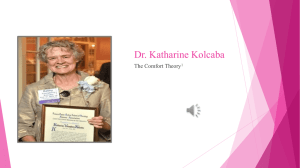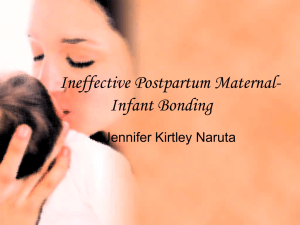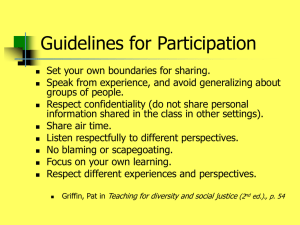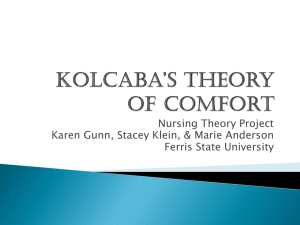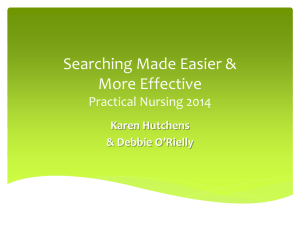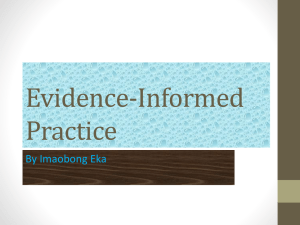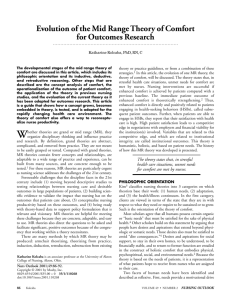Comfort PPT
advertisement
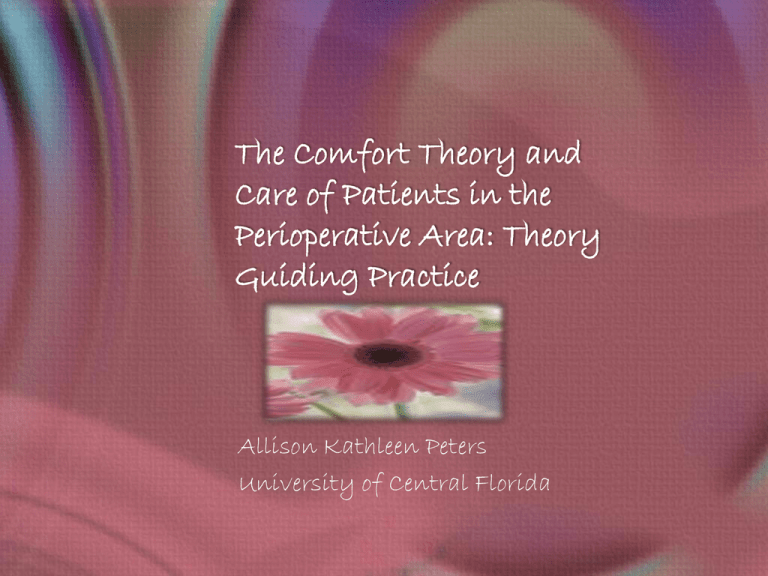
The Comfort Theory and Care of Patients in the Perioperative Area: Theory Guiding Practice Allison Kathleen Peters University of Central Florida Background Comfort Theory Model Designed by Katherine Kolcaba Looks at the whole person with emphasis on the manipulation of the environment such as sound, temperature, furniture Comfort needs occur in the mental and physical contexts of the patient (Kolcaba, 2001) Patients that present to surgery are usually anxious Anxiety produces a physiological rise in catecholamines (raising blood pressure) Also increases cortisol which causes decreased immunity and healing Anxiety caused by waiting for surgical procedure can cause feelings of abandonment, fear of anesthesia and of dying (McCance & Huether, 2006) (Gilmartin & Wright, 2008) Problem Heightened anxiety can lead to poor surgical outcomes Decreased healing Nurses need to recognize anxiety and provide comfort measures Significance Feelings experienced: Uncertainty Relationship between danger or threat Ambiguousness Fear Intervention: Communication Control of environmental factors (light, noise, temperature) Patient control (encouraging feedback, using pain scale, control of environment via RN) (Kagan & Bar-Tal, 2008) (Smith & Liehr, 2008) Specific Aims Raise nurse awareness of comfort levels Facilitation of comforting environment through: Physical Needs: Oxygenation, thermoregulation, pain relief Socio comfort: Cultural sensitivity, positive body language, caring Environmental: Orderly, quiet, safe (Kolcaba & DiMarco, 2005) Theory • A nursing art entailed by comforting actions performed by the nurse for enhanced patient comfort • Intervention needs to be immediate-time is the biggest threat • Focused in nursing • Can be duplicated in many different practices (Kolcaba, 2003) (Smith & Liehr, 2008) Application of the Theory to Clinical Problem Information given to patient Patient verbalizes understanding asks appropriate questions Patient knows what to expect from three perioperative areas Provision of small comfort measures such as warming Not warming can lead to complications such as impaired wound healing, increased blood loss, cardiac arrest and increased wound infection (Burger & Fitzpatrick, 2009). Summary & Conclusion • Assisting patient through comfort measures at a very stressful juncture in life • No cost to implement comfort measures • Increase patient satisfaction scores equals increased revenues to hospital • Application of nurse’s knowledge & critical thinking skills • Promotes healing • Being connected with the patient (Buell, 2008) Reference • Burger, L., & Fitzpatrick, J. (2009). Prevention of inadvertent perioperative hypothermia. British Journal of Nursing (BJN), 18(18), 1114. Retrieved from CINAHL Plus with Full Text database. • Gilmartin, J., & Wright, K. (2008). Day surgery: patients' [sic] felt abandoned during the preoperative wait. Journal of Clinical Nursing, 17(18), 2418-2425. Retrieved from CINAHL Plus with Full Text database . Kagan, I., & Bar-Tal, Y. (2008). The effect of preoperative uncertainty and anxiety on short-term recovery after elective arthroplasty. Journal of Clinical Nursing, 17(5), 576-583. Retrieved from CINAHL Plus with Full Text database. • • • Kolcaba, K., & DiMarco, M. (2005). Comfort theory and its application to pediatric nursing. Pediatric Nursing, 31(3), 187-194. Retrieved from CINAHL Plus with Full Text database. • Kolcaba, K. (2003) Comfort theory and practice. New York, NY: Springer Publishers • Kolcaba, K. (2001). Evolution of the mid range theory of comfort for outcomes research. Nursing Outlook, 49(2), 86-92. Retrieved from CINAHL Plus with Full Text database. • McCance, K.L. & Huether, S.E. (2006) Pathophysiology: The biologic basis for disease in adults and children. (5th ed.) St. Louis, MO: Elsevier Mosby. • Smith, M. J. & Liehr, P.R. (2008) Middle range theory for nursing (2nd ed.) New York, NY: Springer. • Wagner, D., Byrne, M., & Kolcaba, K. (2006). Effects of comfort warming on preoperative patients. AORN Journal, 84(3), 427. Retrieved from CINAHL Plus with Full Text database. • Walker, J. (2007). Patient information. What is the effect of preoperative information on patient satisfaction?. British Journal of Nursing (BJN), 16(1), 27-32. Retrieved from CINAHL Plus with Full Text database.


